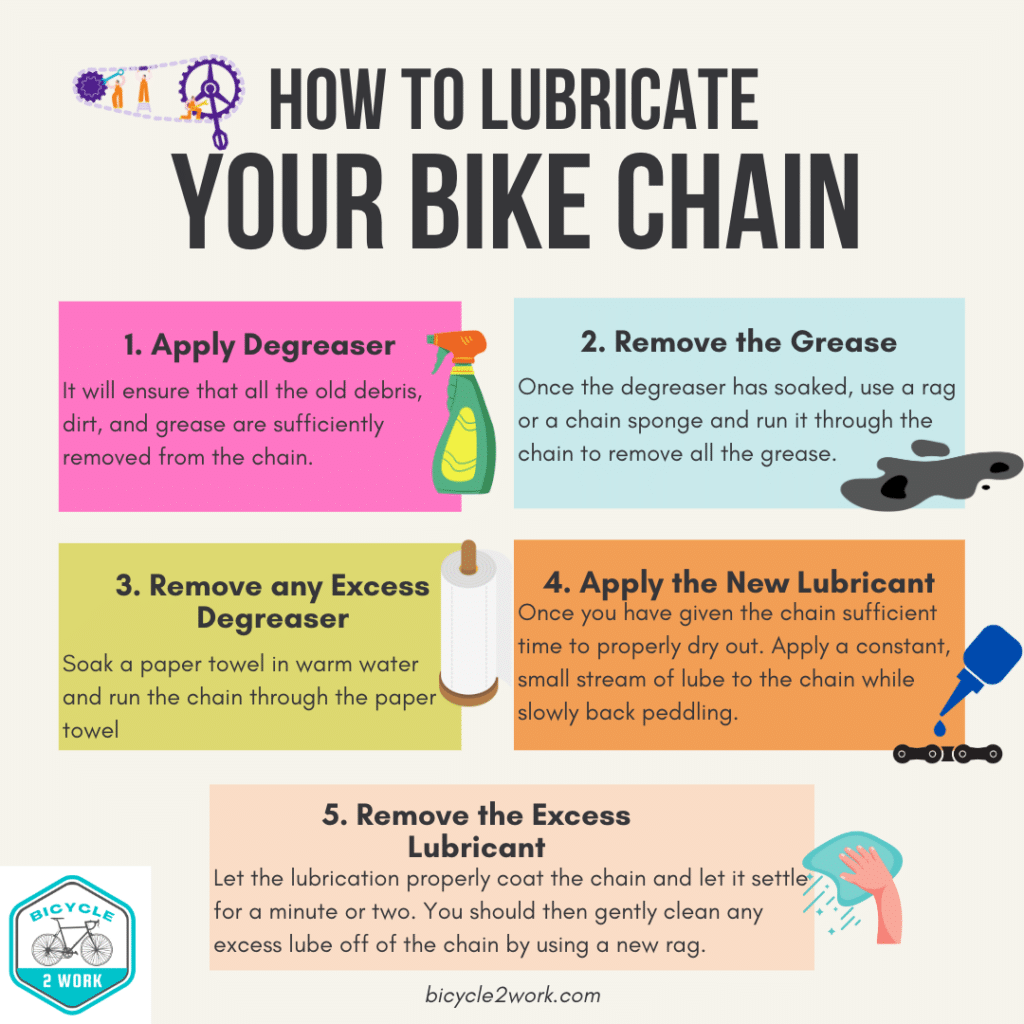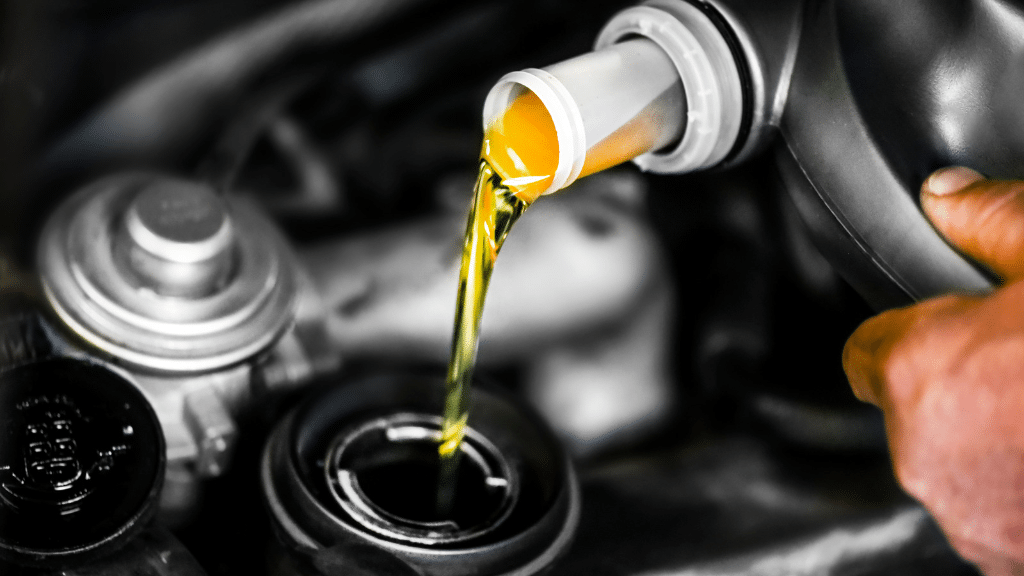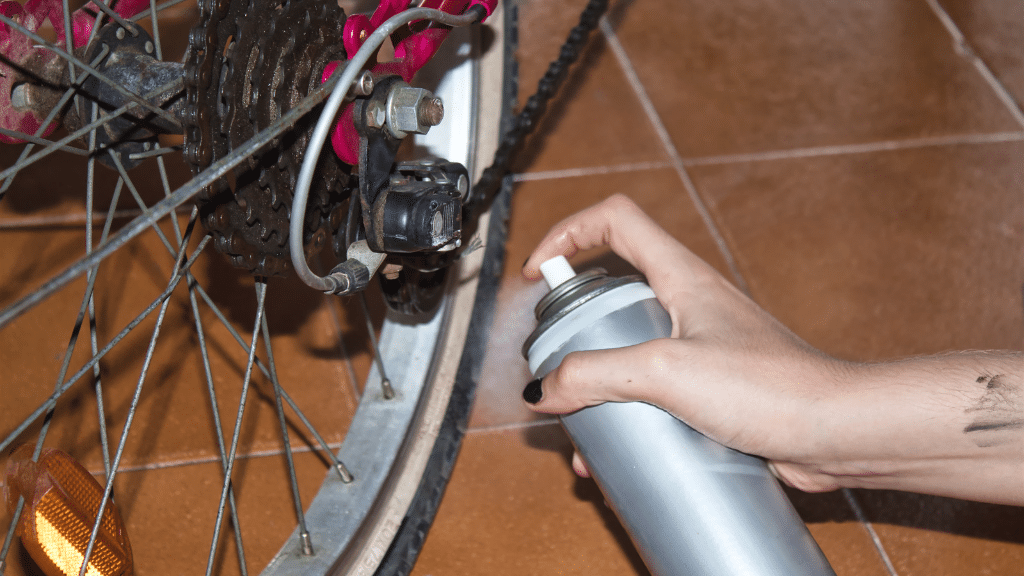This post may contain affiliate links. If you click an affiliate link and make a purchase, I may earn a commission. Also, as an Amazon Associate, I earn from qualifying purchases.--
Your bike’s chain is the most hardworking part of the entire assembly. Even peddling at a slower pace creates a lot of metal-on-metal contact between the chain itself and all the other components of the drivetrain.
A chain that needs to be fixed can make riding a bike far more difficult than it ever needs to be.
There are a lot of lubricants on the market explicitly designed for bike chains, along with many unconventional alternatives.
So what can you use to lube your bike chain? You can use bike-specific lubricants (i.e. dry, wet, ceramic & wax), and alternatives such as engine oil, silicone spray, and 3 in 1 oil.
It is important to understand what lube will work best for your needs, its benefits, and drawbacks. We’ll dive deeper into what you can use, what you can’t use, and why.

Why is Bike Chain Lube Necessary?
Bike chains need to be lubricated regularly as it protects them from rust and reduces friction. Wear and tear causes chains to be more vulnerable to breakage. Therefore, taking good care of your chain not only ensures your bike’s optimum performance but also ensures that the chain is not damaged or breaks apart (source).
The lube protects the chain from the environment. Mud and sand can increase friction on the chain, while rain, snow, salt air, or any form of moisture can accelerate the process of rusting.
After riding through damp areas, signs of rust can begin to appear on the chain within a week, which can be significantly slowed down with the use of lubricant.
The earliest indication that your chain needs lubricant is the noise. A dry chain will get louder due to the abrasive contact between the drivetrain parts. A more audible chain can also show that the chain is dirty and needs to be cleaned and lubricated again.
Shifting capabilities is an integral aspect of the performance of the bike. Problems with shifting will reduce the efficiency of your bike and make you slower. A dry chain can be a leading cause for this making it even more important to keep your chain properly lubricated.
An un-lubricated chain also makes riding the bike more difficult as more force is required to reach faster speed, and you can tire out more quickly. With the proper lube used, much less energy and effort are needed to get to faster speeds, making the bike ride much more efficient and enjoyable.
How to Lubricate Your Bike Chain?
You can reapply lube to your chain through easy-to-understand steps. After selecting a lube according to your requirement, you will follow these five steps to ensure your chain is adequately lubricated.
Apply Degreaser
First, you must correctly clean the chain before you can apply lubricant to it again. Using soap and water will not do the trick as it will not clean the chain as thoroughly as needed.
This is where a degreaser becomes crucial for the job. It will ensure that all the old debris, dirt, and grease are sufficiently removed from the chain. Slowly apply the degreaser while peddling in the opposite direction, ensuring the chain is adequately coated.
Remove the Grease
Let the degreaser sit on the chain for some time. This will allow it to penetrate sufficiently and easily remove the grease from the chain. Once it has soaked, use a rag or a chain sponge and run it through the chain to remove all the grease.
Remove any Excess Degreaser
Next, you should remove the excess degreaser by rinsing it thoroughly with warm water. The easiest way to do this would be to soak a paper towel in warm water and run the chain through the paper towel. Any excess degreaser will break down the newly added lube, meaning the chain will not be adequately lubricated.
Apply the New Lubricant
Once you have given the chain sufficient time to properly dry out, it is time for you to apply the new lubricant. Apply a constant, small stream of lube to the chain while slowly back peddling. Make sure that the chain is evenly coated and that there are missed spots. The best way is to apply it to the top of the lower chain part.
You can run your finger across the chain to check if all the links have been completely saturated.
Remove the Excess Lubricant
Let the lubrication properly coat the chain and let it settle for a minute or two. You should then gently clean any excess lube off of the chain by using a new rag.
Excess lube that isn’t removed can be a magnet for dirt, grit, and other debris. This will subject your drivetrain to abrasive damage, effectively counteracting all the benefits you might get from the lube.
Here’s an infographic with all the steps, to save or share with your biking friends and colleagues:

Types of Bike-Specific Lubricants You Can Use
There are many bike-specific lubes on the market, each with its advantages and disadvantages and designated use, which we will cover. The different types include dry, wet, wax, and ceramic lubes.
Most lubricants have synthetic oils present in them as well as additives that reduce friction, such as Teflon (source). They also contain carrier fluids that evaporate once the lubricant has been applied.
Recently, there has been an increase in the popularity of wax-based lubricants among cyclists geared toward higher performance.
Do not only think about price when picking a lube to buy, as a cheaper lube that isn’t quality could cost you more in the long run due to its sub-par performance.
Types of Lubes
Now, let’s discuss the different types of lubes manufactured for use on bike chains and all their benefits and drawbacks, along with the specific conditions they are made to be used.
Dry Lube
Dry lubricants are specifically designed to be used in more dry conditions and consist of 10% lubricant made of synthetic oils and additives. The remaining 90% is made up of carrier fluid. Some companies also label wax-based lubricants as dry lube.
Dry lubes offer much greater efficiency with significantly reduced friction and catch much less debris. This is because the oil is low-viscosity. The disadvantage of dry lubes is that they can get easily removed through water and riding through rain or puddles.
Some experts deem dry lube to be ineffective as it contains a very little actual amount of lubricant.
Wet Lube
Wet lubes are designed to be used in more damp and all-year conditions. This lube has a much higher proportion of lubricant and viscosity. The greater thickness means that the lube should have a much longer lasting period and be less likely for the lube to get washed off with water or rain.
The added benefits of this kind of lube can also cause issues. The greater lubricant content means more dirt and gunk will be attracted, mainly if applied excessively. The greater viscosity will also decrease the efficiency of the bike’s performance, mainly due to the viscous drag.
The drivetrain also needs to be cleaned regularly, as once a wet lube gets debris on it, it can be worn down off the drivetrain.
Ceramic Lube
Ceramic lubes are a new addition to the lubricant market. They came onto the scene with claims of much higher performance but much greater prices.
There are both wet and dry kinds of ceramic lubes. They are said to contain small ceramic particles that reduce friction to a greater extent when compared to synthetic oils in standard lubes.
The greater price of ceramic lubes can be overlooked due to the reduced friction, and increased efficiency increases the drivetrain’s longevity. The increased longevity reduces costs in the long run due to less damage to the drivetrain.
Wax lube
The wax lubes gained a lot of popularity in recent years among cyclists. This lube is based on paraffin wax (source) and has shown remarkable results in increased performance, longer lifespan, and much more contaminant resistance.
The wax lube is made from highly refined paraffin wax particles with additives such as Teflon and a carrier fluid. For the proper performance of the lube, the wax needs to settle entirely and form a hard, dry, and frictionless coating on the entire chain.
The dryness of the lube ensures that friction-causing contaminants are less likely to stick to the chain and damage the chain or the drivetrain.
Here’s a summary of all the various types of lubes and the benefits of each:
| Type | Benefits |
| Dry lube | Specifically designed to be used in more dry conditions and offer a much greater efficiency with significantly reduced friction, and they catch much less debris. |
| Wet lube | Designed to be used in more wet and all-year conditions, and greater viscosity means that the lube should have a much longer lasting period. |
| Ceramic lube | There are both wet and dry kinds of ceramic lubes. They are said to contain small ceramic particles that reduce friction to a greater extent when compared to synthetic oils in standard lubes. |
| Wax lube | This lube is based on paraffin wax and has shown excellent results in increased performance, longer lifespan, and much more contaminant resistance. |
I found this video quite useful in picking the right lube to use:
Alternative Lubes You Can Use
While chain lube is the ideal tool to use on your chain and will give the best results, you might be looking for a cheaper solution or need a quick fix.
Grease
The use of household grease is every day when it comes to brake replacement or changing gear cables. Grease can be a temporary fix but lacks the properties necessary for a long-term solution. Grease can maintain its thick viscosity even at very high temperatures, so it cannot correctly coat all the small parts of the chain.
Grease is incredibly sticky, making it a magnet for dirt and debris, and a thick and abrasive paste forms. The paste can extensively damage and speed up the breakdown of your chain. A damaged chain will end up wearing out your cogs and cassette. Grease is also tough to remove from the chain when changing lube.

Engine Oil
Engine oil, like most alternatives, can work in a pinch. It is designed to operate at much higher temperatures and speeds than those found on bikes. It will remain thick at the rates of your bike, making it difficult for the viscous oil to reach all the parts of the chain, and it will take longer to coat the chain.
As it is thicker and stickier, it will gather up more dust and grime than regular bike chain lubricant. If you used it for an extended period, it would become dirtier, causing wear and tear on your chain.

Cleaning motor oil from your bike chain is also challenging because it is resistant to more moderate degreasers. You’ll need to use something more powerful to remove the motor oil from your bike chain.
Sewing Machine Oil
Since sewing machines contain tiny yet fast-moving components, the oil’s viscosity is relatively thin. It must be reapplied every eight hours of stitching. You would have to constantly apply oil to the chain due to its low staying power.
Sewing machines are also used in a reasonably regulated atmosphere, with moderate temperatures and little dirt. Therefore, sewing machine oil isn’t designed to protect against the dirt and extremes a bike would encounter on the road.
3 in 1 Oil
One of the top alternatives to bike chain lubricant is 3 in 1 oil. 3 in 1 oil is mineral oil, which implies it is derived from petroleum. It was designed to strike a balance between performance and protection. In other words, when used as a chain lubricant, this oil will preserve your drive train from wear and tear while also reducing friction, which loses energy.
Silicone Spray
Silicone has several advantages, including retaining its greasiness even at high temperatures, the inability to react to most chemicals, the inability to rust, and low friction.
Silicone spray is fantastic because of its aerosol nature, which allows it to go into all kinds of tiny nooks and crannies, making it ideal for getting into the little portions of a bike chain. The disadvantage of silicone spray is that it is readily removed.

Takeaway
If you have the correct bike chain oil, you can avoid being stuck with a dry chain. But sometimes, you don’t have what you need and must settle for an alternative.
Several other lubricants will work in a pinch, but only as a last resort and not regularly. Clean the chain and apply proper bicycle chain oil as quickly as possible for your peace of mind.
